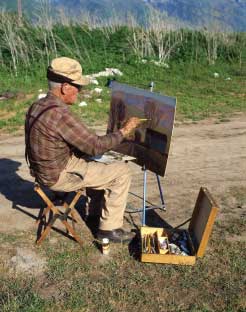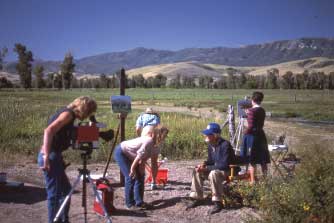LeConte Stewart: The Soul of Rural Utah
Largest exhibition of LeConte Stewart works ever mounted

- Visit the LeConte Stewart: The Soul of Rural Utah online exhibit at the Church History Museum
- Visit the LeConte Stewart: Depression Era Art online exhibit at the Utah Museum of Fine Arts
LeConte Stewart (1891–1990) was a great American landscape artist best known for his masterful paintings of the agricultural lands and rural settings of Utah. He portrayed the spirit and beauty of the land in thousands of artworks created over many decades. These landscapes include the sagebrush deserts of central Utah, the mountains and valleys of northern Utah, and the rural homes and farms of Mormon pioneers—a distinctive regional landscape. Paralleling this artistic work was a lifetime of teaching and service to The Church of Jesus Christ of Latter Day Saints, including the creation of religious murals and paintings for Latter-day Saint temples and meetinghouses.
The great focus of LeConte Stewartʼs artistic life—landscape painting—was a process to which he brought his innermost beliefs and feelings, his connections to the land and people of Utah, and his abilities as an artist. During the years when he supported his family through his teaching, he produced artworks after school and on Saturdays, when he often created six artworks in one day.
Major retrospectives of his art were presented in 1962 (the Salt Lake Art Center), 1975 and 1978 (the Utah Museum of Fine Arts), and 1985 (the Church History Museum). The two major concurrent exhibits being presented two decades after his death are evidence of the importance of the work of LeConte Stewart.
The Soul of Rural Utah
One reason LeConte Stewartʼs art captures so well the essence of rural Utah is that the areas he painted often do not have the dramatic beauty that other artists express. He most often selected seemingly desolate or nondescript places to paint, seeing beauty where others did not—hidden beauty within forlorn places.

From his boyhood on, Stewart loved the uninhabited Utah landscape, but he found himself drawn to the less spectacular scenes. His paintings explored the quieter desert forms of buttes, mesas, and sagebrush. As an artist, he did not mechanically copy nature as it would be seen through a camera. Using a kind of visual poetry, he brought out the essence of the things he saw. He sought to render on canvas the way the mind understands and feels the subject, expressing the meaning or spirit of the scene using sound composition and an advanced artistic vocabulary acquired from artists and teachers at the finest art schools in the United States. Stewartʼs feeling and care for this land, his deep-seated beliefs, and his rich experience in visualizing the land—seeing Utahʼs unique light, the fleeting effects of weather and vegetation, and the balance between man-made and natural elements—made him uniquely able to portray the landscape of a time, place, and people.
LeConte Stewartʼs religious beliefs were an important influence on his art. Stewartʼs art reflects the quiet humility he felt as he discovered the hand of God upon the land. Throughout his life, he was grateful that his work allowed him to observe Godʼs creations and express his feelings about them. For Stewart, true art was not found in perfect natural compositions or the most paintable subjects, but rather in humble and visually unpretentious scenes—made beautiful by the soul of an artist who loved them and expressed them with integrity and sensitivity.
Master Teacher

Stewart had a profound influence on regional art history. His teaching career lasted from 1912 to 1990. Most significantly, Stewart was appointed chairman of the Art Department at the University of Utah in 1938, a position he held until 1956. After his retirement he taught classes and mentored individual students on site. He was a beloved teacher and students valued his classes. His teaching and example launched the art careers of a number of his students.
Collaboration
The largest exhibition ever mounted of the work of LeConte Stewart is the result of a collaboration between the Church History Museum and the Utah Museum of Fine Arts. Over 200 paintings and works on paper will be exhibited, including rarely seen masterworks from private and public collections. The Church History Museum's LeConte Stewart: The Soul of Rural Utah and the UMFA's LeConte Stewart: Depression Era Art focus on the appearance and character of rural settings, cityscapes, and works with human interest that Stewart felt must be recorded before their distinctive features disappeared. The complementary exhibits provide important insights into the motivations and inspirations of this masterful artist.